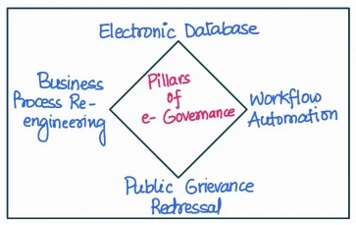Answer:
| Approach:
Introduction
- Briefly introduce the concept of e-governance and its objectives, highlighting the importance of the ‘use value’ of information in addition to leveraging new technology.
Body
- Discuss the various aspects of the ‘use value’ of information in e-governance initiatives, such as relevance, accessibility, applicability, transparency, and citizen participation. Provide examples to illustrate each aspect.
Conclusion
- Sum up the importance of focusing on the ‘use value’ of information in e-governance and how it can contribute to better service delivery, enhanced transparency, and increased citizen engagement.
|
Introduction:
E-governance refers to the application of information and communication technology (ICT) to deliver government services, exchange information, facilitate communication, and improve the overall efficiency, transparency, and accountability of government processes.

Body:
While the use of new technology is certainly a key aspect of e-governance, it is also crucial to recognize the importance of the ‘use value’ of information.
- Relevance of Information: E-governance initiatives should focus on providing relevant information that directly addresses the needs and concerns of the citizens. For example, during the COVID-19 pandemic, relevant information like vaccination schedules, safety guidelines, and helpline numbers became critical for the public.
- Accessibility: This includes offering information in multiple languages, making websites and applications user-friendly, and providing alternative channels (like SMS or voice-based services) for those who lack internet access. For instance, the Government of India’s Umang App provides more than 1200 central and state government services in 13 Indian languages.
- Applicability: For example, providing real-time data on the availability of hospital beds, oxygen supplies, and medicines during a health crisis empowers citizens to make critical decisions for their well-being.
- Transparency and Accountability: For instance, the implementation of the Right to Information (RTI) Act in India has made it easier for citizens to access information on government functioning and decisions, fostering greater accountability.
- Citizen Participation: The My Gov platform in India is an example of a platform that facilitates citizen engagement in policy formulation and program implementation.
Conclusion:
While new technology plays an essential role in e-governance, it is the ‘use value’ of information that ultimately determines the success of such initiatives. By focusing on the relevance, accessibility, and applicability of information, governments can ensure that e-governance initiatives lead to better service delivery, enhanced transparency, and increased citizen engagement.
